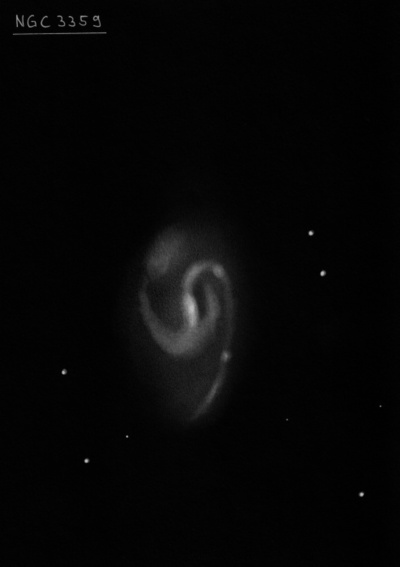
William Herschel discovered NGC 3359 = H V-52 = h745 on 28 Nov 1801 (sweep 1102) and recorded "cB, L, lE in the meridian, vgbM, about 5' long and 3' broad. The nebulosity seems to be of the milky kind [unresolvable], it loses itself imperceptibly all around. The whole breadth of the sweeps seems to be affected with vF nebulosity." His position was 3.5' too far north. On 2 Apr 1832 (sweep 411), John Herschel logged, "pF; L; E in merid; glbM; 2.5' l, 2' br."
Ralph Copeland, observing on 21 Feb 1874 at Birr Castle, made two sketches showing both a striking "S" shaped spiral and a "figure 8". No description accompanied the diagrams.
400/500mm - 17.5" (3/12/94): fairly bright, large, elongated 3:2 SSW-NNE. A brighter bar is visible through the center along the major axis! Has a large, diffuse halo about 5'x3' which fades into the background. The brighter core has an irregular surface brightness. Two mag 14 stars are 3.4' WNW and 2.8' ESE of center.
900/1200mm - 48" (2/21/12): at 375x, this beautiful barred spiral contains a prominent central bar extending ~1.3' N-S, with a bright, elongated core. A spiral arm is attached at the south end of the bar. It quickly rotates and sweeps northeast (clockwise) for 1.5', dimming out 1' E of center. A longer, beautiful arm is attached on the north end of the bar and sweeps south along the west side of the galaxy. This arm is brightest where it attaches to the bar. The western arm passes well south of the central bar and includes a couple of HII knots towards the end. The brightest is a faint 10" knot, situated 1.4' SW of center. This HII region is catalogued as [H69] 42 in Hodge's 1969 paper "HII Regions in 20 Nearby Galaxies" and as SDSS J104627.95+631220.6 (V = 16.5). It is also referenced in NED as NGC 3359:[RZB2000] #7/9, from the paper "The ionized gas in the spiral galaxy NGC 3359. Part I." in A&A, 354, 823-835 (2000). Just south of this knot the arm fades out, but brightens slightly again at the tip (2' S of center), where there is a very faint, low surface brightness knot, ~12" diameter, listed in the RZB paper as region #12/14.
Notes by Steve Gottlieb